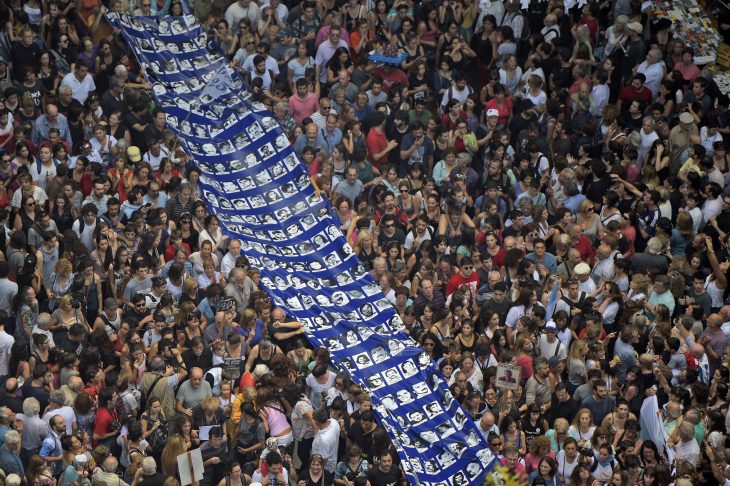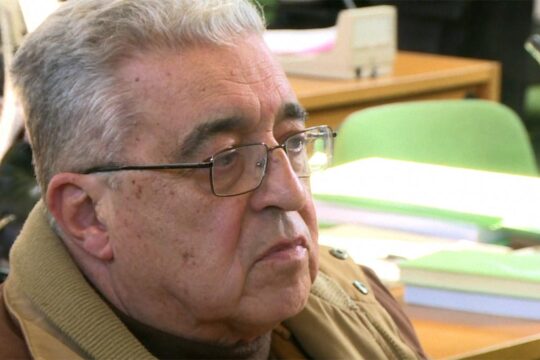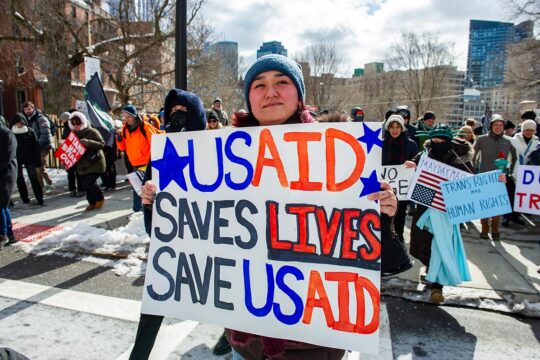On 24 March 2016, hundreds of thousands of Argentines flooded the streets around Buenos Aires’ Plaza de Mayo to commemorate the 40th anniversary of the country’s bloody 1976 military coup. The date also marked the UN Day on the Right to Truth, making it a unique invitation to reassess Argentina’s transitional justice legacy 33 years after the post-coup regime collapsed, in the aftermath of economic collapse and military defeat, after the 1983 Falklands/Malvinas war.
The recent commemoration, which some say was the largest ever, was a far from sober affair. Whistles, drumbeats, extravagant costumes, street theatre, and even impromptu street corner barbecues were the order of the day. The large contingent of young people present lent exuberance, brio and colour. Even the capital’s iconic obelisk was decorated for the occasion, with 50-metre--long banners on its four faces reading ‘Truth’, ‘Justice’, ‘Memory’, and ’40 years’. The Argentine national football team, in Chile for a fixture, unfurled similar banners in the dressing room before the game.
These very public manifestations gave the impression of a country united as never before in repudiation of its dictatorial past. This impression is largely accurate. Argentina is one of few countries where past crimes amounting to state terrorism are routinely referred to as such in official discourse. Special prosecutor’s offices and other official agencies were set up, particularly in the period since 2000, to bring legal proceedings against perpetrators, trace abducted children, collect DNA samples, and improve existing registers of victims and survivors. The policy of robust criminal prosecution of former military officers and their civilian collaborators, including business leaders and judges, was even given cross party support in a unanimous Congressional vote in 2010.[1]
Notwithstanding this apparent unanimity, Argentina’s transitional justice scenario has its share of problems and contradictions. The confluence of thousands in the Plaza on 24 March hid sharp differences between some human rights organisations, political groupings, and relatives’ associations such as Madres de la Plaza de Mayo. The world-renowned group of mothers of the disappeared has itself, in fact, been split, since 1986, into two autonomous factions, due to internal disagreement as to whether to accept and take part in state measures such as the official Truth Commission, or strategies to identify and exhume the remains of the disappeared.
Some of the tensions have to do with different reactions to the country’s recent thirteen-year period of consecutive ‘Kirchnerista’ Peronist governments (2003-2016), referred to collectively as the ‘gobiernos K’. These administrations took up the cause of accountability for past human rights violations, attempting to make it a defining feature of their mandates in ways that some resisted and others embraced. Certain sections of the crowds lining the Plaza and Avenida de Mayo were more visibly and vocally ‘pro-K’ than focused on the anniversary at issue or repudiation of past authoritaranism, and their easy and sometimes virulent denunciation of recently elected right-wing president Mauricio Macri as a ‘new dictatorship’ seemed questionable, not least at a purely formal level, since he was in fact elected in a close, but clear, second-round runoff against continuity candidate Daniel Scioli in November 2015.
The coincidence of the anniversary date with an official visit to Argentina by US President Barack Obama, fresh from his historic date in Cuba, further exposed political fault lines and polarisation. Protocol around the visit demanded that US flags be flying in the Plaza de Mayo on the coup anniversary. This was admittedly incongruous or infelicitous, given the US’s historic complicity in installing and propping up the region’s murderous 1980s military regimes. Obama perhaps wisely made himself scarce for most of the actual anniversary date, heading off for an anodyne visit to the spectacular Argentine Patagonian countryside. Earlier proposals to have him visit an emblematic former clandestine torture centre (The Navy Mechanical School, known as the ‘ESMA’) had to be abandoned, after vigorous protest and the threat of a boycott from social movements and human rights groups, including Madres and Abuelas (Grandmothers) of the Plaza de Mayo.
Obama did visit the capital’s other major memory site, the Parque de la Memoria, on the morning of the 24th. Together with President Macri, he threw flowers into the Rio de la Plata river, in remembrance of political prisoners and other regime opponents drugged and dropped alive into those same waters from helicopters during the military’s seven-year reign of terror. The gesture drew criticism from those determined to convict both presidents of insincerity or inadequacy. For instance, Obama, in his speech at the Parque, avoided the language of complicity or apology, choosing to speak only of the US’s having been ‘slow to denounce’ human rights violations in Argentina.
Obama did pay explicit homage to the tenacity and courage of relatives’ associations in seeking truth and justice. The main such associations (both factions of Madres, plus Abuelas (Grandmothers) of the Disappeared) had, however, taken a collective decision not to attend the official event. Their own energies and efforts were instead channelled toward commemoration on the public stage, and in the streets, long after the presidential cavalcade had come and gone. Policing around the city’s key public spaces was light and almost absent; leaving the streets to the multitudes who gave voice to a range of political and social demands, linking the past human rights violations to present concerns and exploitations. Celebration of the current wave of prosecutions of military perpetrators was also evident; but, in the words of a former human rights professional, “sending the old guard of state terror to prison for life won’t in itself be enough to turn history around”.
Advances in formal (criminal) justice for Argentina’s past crimes should not, in other words, be allowed to obscure or gloss over remaining gaps, contradictions and challenges to full accountability. Certain issues that were never resolved prior to the K period became virtually unmentionable during it. These include the numerically minor, but real, measure of left-wing political violence that unleashed before the 1976 coup by guerrilla groups (more than matched in ferocity, it should be said, by an extreme right-wing paramilitary/parapolitical organisation known as the AAA), as well as the issue of the numbers of those killed and forcibly disappeared at the hands of state forces.
With regard to the latter, in particular, a figure of 30,000 has become an article of faith amongst human rights groups and in left-wing circles. Departure from or questioning of this figure risks being equated with revisionism or downright mischief; and yet the official truth commission, carried out in 1983, listed just under 9,000 individual victims of forced disappearance. An updated and ongoing official victims’ register reported in December 2015 (before the change of administration) a running total of 8,552 persons killed or forcibly disappeared between 1976 and 1983. Precise and detailed in spelling out definitions used and sources consulted, which include recent judicial investigations, the report rightly concludes that more research and careful diligence are needed. Determining the right numbers matters, not solely because every individual life matters, but also inasmuch as the truth itself matters, ethically, legally, and socially.
The logic of taking the numbers seriously is not solely humanitarian nor individualistic: it also speaks to the need to construct a more complete picture of the political and social profiles of victims of state terror, essential if correct inferences are to be made about intent, prevention, cause, and effect. As Argentine political scientist and Truth Commission expert Emilio Crenzel has pointed out, a discrepancy of this magnitude in the historical record of a relatively developed, state-centric nation where massive state-sponsored repression was vocally denounced at the time it occurred, and has subsequently been closely scrutinised for over three decades, bodes ill for confidence in the accuracy of similar records elsewhere. It also risks fostering a somewhat cavalier attitude by which only truths congruent with existing political or discursive positions are acknowledged or pursued.
Argentina recently reported a historic trial verdict in the ‘Operation Condor’ case, finding various high level former military figures guilty of a region-wide conspiracy to torture and disappear dissidents during the 1970s and 1980s. The coincidence of the Argentine coup anniversary with the UN Day for the Right to Truth perhaps underlines the fact that truth should not be treated as a mere adjunct to such judicial proceedings, but as a valuable social and political force in its own right. Argentina needs to either trace, recover, and fully value 20,000 as yet unknown histories, identities, political projects, and truncated lives, or to responsibly revise acknowledged numbers, and associated truths, about the dictatorship’s victims, as individuals and as social and political collectivities.
[1] See Balardini, Lorena ‘Argentina: regional protagonist’, in Skaar, Elin, Jemima García-Godos and Cath Collins (eds.) 2016. Transitional Justice in Latin America. Routledge. p. 63.






